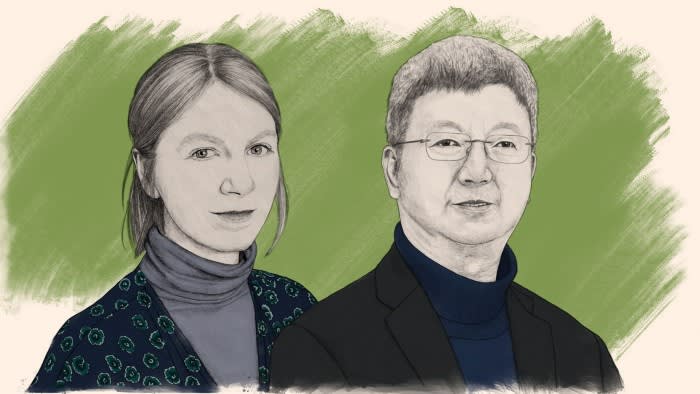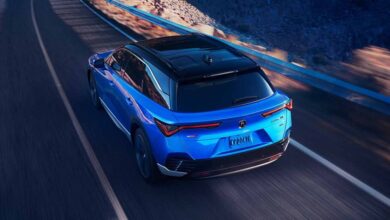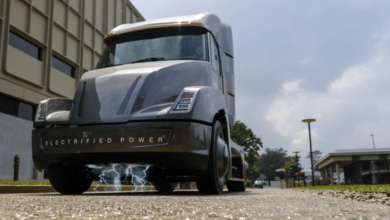People talk about ‘overcapacity’ . . . but EVs are just evolving fast

Zhu Min, the economist and member of China’s powerful five-year plan committee, was in Europe last month for discussions with officials in the bloc, to coincide with a much-anticipated visit by President Xi Jinping.
The arrival of the Chinese delegation took place against a backdrop of anti-subsidy probes being launched by Brussels into solar panels and electric vehicles exported by China, and the threat of tariffs on imported Chinese EVs, which have since been announced.
Zhu, who is also a former deputy managing director of the IMF, has previously held senior positions at the Bank of China and was a deputy governor of the People’s Bank of China.
In an interview with the FT’s EU correspondent, Alice Hancock, in Brussels, he reflected on the key geopolitical and trade issues, and flagged a boost to its electric grid and carbon pricing system, as part of China’s rapid progress in decarbonising its economy. This is an edited transcript.
Alice Hancock: Europe is heavily under pressure from the US to be more protectionist, and we have these probes on many fronts now. Do you see a way that trade tensions can be relieved?
Zhu Min: Let me take one particular [issue], which is overcapacity [in China’s car industry] — is there any particular evidence to say that? People just use that term.
Economically speaking, there are a few things to ask: number one, whether there’s a government subsidy. The answer is no, because most of the EVs produced in China are [manufactured by] the private sector.
China does subsidise the consumer, but now not very much so. But that is open to everyone: if you buy a Tesla, you get a subsidy. So it’s sort of universal. The Chinese government [did] put money into charging, providing infrastructure to make things easier, this is true.
But the [main] issue: is there dumping [when a product is exported at a lower price]? The answer is no. BYD sells the same car in China for around €20,000, but here [in Brussels] it is €40,000, and that is still lower than the €60,000 for a Volkswagen . . . so [VW] still makes more money per car per sales. So it’s not dumping.
Overcapacity is a concept that’s not easy to define. EV companies are competing furiously . . . they are evolving very fast. A car is really now [like] a semiconductor, so people say it’s quite a lot of capacity made, but it’s just evolving . . . the adaptation [of the semiconductors] is moving very, very fast.
The real concern from Europe, and from others, is that the scale and the speed of growth is too big. So, during a very frank conversation, people say, yeah, we can adjust to Japanese cars, we can adjust to Korean cars, but it’s hard to adjust to Chinese cars, [because of] the scale [of it].
When people talk about trade measures . . . it’s not only a tariff issue. The US is very politicised on this issue. We need to find a way between the trade measures and the political [rhetoric], the instruments of the politicised discussion, in some middle way to solve this issue.
Ideally, [that would be] under a multilateral framework. But, unfortunately, the WTO [World Trade Organization is] not functioning very well.
Europe has its own concerns. The auto industry is very important for the Germans and the French . . . they are obviously very sensitive. I listen, and they say it takes time to adjust, and they have to make sure their industry is still there. So we do need to find a way.

[Perhaps some solutions would be] reverse investments: for China to invest more in Europe. And reverse technology transfer. I think Europe, and also the US, have a lot of technology in renewable energy. But China also [has] some. In the [past] 40 years, you know, it has been importing a huge amount of technologies and capital from Europe and the United States. But now we are also moving close to the frontier line.
So it’s time for China to export technology. Are there lessons in the production of batteries, for example?
AH: Could I ask about China’s carbon market? I just wondered how you see progress on that?
ZM: China’s very much committed to [tackling] climate change. One reason is because of international commitments. But, more importantly, it’s really good for China because the previous model [of burning fossil fuels] is not sustainable. We’re not only polluting the air, we’re polluting the water and the soil.
So carbon neutrality is bringing a really fantastic opportunity for China.
AH: China is building a lot of coal power stations, too.
ZM: As we move to a green path, [replacing coal power] is very important [coal accounts for 60 per cent of China’s energy needs, according to data from the IEA]. Remove this coal and replace it by renewable energy — that is a huge market.
I know it’s a long way [to go], because the economy is still growing. Energy demand increases on two measures: first, the economy is growing at 5 per cent, still very strong, and the second issue is people use more electricity, because of all of the devices [we now have].
We used to have energy demand growth of roughly, say, 2.5 per cent, now we have a 3 to 4 per cent increase in energy demand growth every year.

So the first target is to make sure renewable energy replaces all the energy demand growth. It would take two more years, say 2026 or 2027.
Then, I think we’ll be able to peak [emissions] at 2028. So [at around that point we will begin to see] the coal plants stop — there are a lot in [the] pipeline — and see [power] storage increase from 2030.
As a member of the 14th five-year plan committee, [I know] you have to be very careful in cutting coal.
You have to [make up the] supply with renewable [energy], and you have to think about whether the grid system can support the renewable [energy]. It is very delicate thing.
So, people do complain that China imports coal from Australia, for example. But we are two years within reach [of] the [emissions] peak, and [then] we are going down.
China is very committed. It is really, really important for China to make the whole model more sustainable. And we are moving very fast.
Solar cost [in some parts of China] is roughly €0.02 per kilowatt. With €0.02 production cost, you can produce green hydrogen, and the cost is roughly $2.50 per kilo, which is the international low bar now.
So whole hydrogen supply chains are building [out] . . . it’s very important for storage, for transport, for many other things.
And China is continuing to build nuclear power stations — we have 12 under construction and are building [many more] over the next 20 years.
The whole purpose is to replace coal. Because you need a stable power supply. I think this is showing China is very much committed to moving very fast.

[Electricity] storage is a big issue because there’s so much solar capacity now but not absorption capacity. And you cannot upload [solar power] to the grid system because the [absorption capacity] is just not here.
So you need to build a decentralised system. We’ll come to those issues. I think, in 10 years, we’ll be able to build a digital system for the grid.
But the first issue is storage. The second issue is you have to reform the grid. The third issue is to continue to reform the carbon market.
AH: Do you foresee a point where China’s carbon market gets to the same price as in Europe?
ZM: The current market is just the starting point. [China has] only 2,000 power companies, now we’re keen to expand to cement, steel, aluminium . . . so we will bring more companies [into it].
But this is not the real issue. The issue is the [market] mechanism is not good. We gave the [carbon emissions] quota for free. So we’re gradually going to build a market mechanism for carbon.
Currently, it is roughly €12 per tonne [of carbon dioxide]. Europe is €70-80 [per tonne], so there is a gap. But, by IMF estimations, roughly, developing countries should have a price of around €25 and middle income €50 and [developed countries] €70-80 to €100, because they can be structured differently.
AH: China is regarded as middle income.
ZM: China is middle income, but China is a heavy industry economy. So China cannot absorb a very high price for carbon. For example, China produces half of global cement, so you [would raise] the cement price by 100 per cent.

It is a very careful, step by step [approach]. But we need to expand the scope, deepen the system and introduce the market option to the CCER [China Certified Emission Reduction] system, and bring in the voluntary system as well. And, in some way, the system can have some link with the European market.
AH: Is China developing its carbon market in part because of the EU’s carbon border tax: the Carbon Border Adjustment Mechanism (CBAM)?
ZM: CBAM is becoming part of the reason, because CBAM is imposing a European standard on everyone. But it is more important [to reform] for domestic [reasons].
The CBAM impact is at early stages still and not terribly big. It is a concern because it is not a WTO framework. We would like to solve this issue under multilateralism. But China has to develop this whole thing, the broader scope and the market mechanism and involving more trades, as the trade is very low.
AH: How long do you think it would take to scale up that market?
ZM: We would do big reforms this year and then next year, in terms of extending the scope and introducing auction mechanisms.
I think [China] would very much welcome solid communication with Europe. Very much. That would involve a lot of a standards, disclosure, measurements. Because, unless you can finally measure the carbon you are emitting, the data quality is under question.
So there’s a lot of institutional building capacity. But we will have to, because we have to send a clear, strong price signal to the markets. That’s the most important thing.
If China is determined to [achieve] carbon neutrality, you’ll have to set the carbon market right. So, in that way, I think China will move forward.
Climate Capital

Where climate change meets business, markets and politics. Explore the FT’s coverage here.
Are you curious about the FT’s environmental sustainability commitments? Find out more about our science-based targets here



